The City Council adopted the proposed amendments on December 5, 2023, with an effective date of April 30, 2024. For information on the using the AHI, see Salt Lake City’s Guide to Affordable Housing Incentives. For more information on the Council process see the Salt Lake City Council Affordable Housing Incentives page.
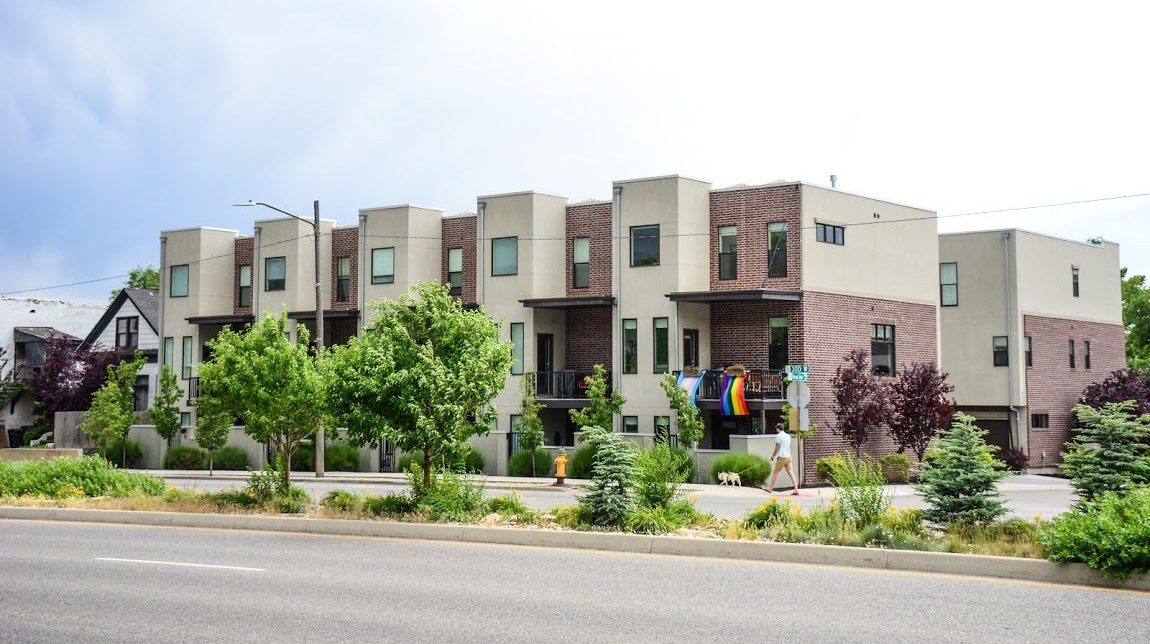
Affordable Housing Incentives
Zoning Text Amendment
The City’s Planning Division drafted zoning amendments to encourage the construction of additional affordable housing through Affordable Housing Incentives (AHI).
The amendments provide incentives to developers who include affordable homes in their projects. The AHI encourage the development of affordable housing rather than require it. This is through zoning code modifications allowing for additional height in some zoning districts, reducing parking requirements, allowing additional housing types and units in some zoning districts, and waiving or modifying planning processes.
Rather than imposing restrictions, the AHI provide developers with more choices by offering additional benefits to projects that increase the supply of homes that more people can afford. The intent of the AHI are to enable development that may not otherwise occur and allow for additional affordable units in projects already providing affordable units.
Current Proposal Information
- Staff Report and Attachment E – April 2023 (pdf)
- Affordable Housing Incentives (with draft language) – March 2023 (pdf)
- Affordable Housing Incentives Summary – March 2023 (pdf)
- Resumen de Incentivos de Vivienda Accesible – Marzo 2023 (pdf en Español)
- Development Options for Single- and Two-family Zoning Districts – May 2022 (pdf)
- Preservation of Existing Housing Options for Single- and Two-family Zoning Districts – March 2023 (pdf)
- Staff Memo – March 2023 (pdf)
Past Proposal Information
- Affordable Housing Incentives – Summary of Comments – July 2022 (pdf)
- Affordable Housing Incentives Staff Report – May 2022 (pdf)
- Affordable Housing Incentives Summary – January 2022 (pdf)
- Resumen de la Propuesta – Incentivos de Vivienda Accesible – Enero 2022 (pdf en Español)
- Affordable Housing Incentives (draft language) – January 2022 (pdf)
- Affordable Housing Incentives (without draft language and appendices) – January 2022 (pdf)
- Affordable Housing Incentives – Mixed-Use and Multifamily Summary – April 2022 (YouTube)
- Affordable Housing Incentives – Middle and Single-family Summary – April 2022 (Youtube)
- Facebook Live Q&A – February 16, 2022 (YouTube, Salt Lake City Government Facebook)
- Information Sheet – December 2019 (pdf)
- Project Update – June 2020 (pdf)
- Affordable Housing Overlay Story Map – Summer 2020 (ArcGIS StoryMap)
- Virtual Open House – July 2020
Past Outreach Events
The following events were held:
- April 5, 2022, 9-11 a.m. – Virtual Office Hours (Hablente de Español disponible).
- April 5, 2022, 5-7 p.m. – Open House at Sugar House Fire Station #3, 2425 South 900 East.
- April 12, 2022, 6-8 p.m. – Open House at Unity Center, Black Box Theater, 1383 South 900 West, (Hablente de Español disponible).
- April 14, 2022, 3-5 p.m. – Virtual Office Hours.
- April 19, 2022, 2-4 p.m. – Open House at Riverside Park East Pavilion, 1400 West and Leadville Avenue (Hablente de Español disponible).
- April 21, 2022, 1-3 p.m. – Open House at Lindsey Gardens Pavilion, 426 M Street.
Frequently Asked Questions
Why make these changes?
Affordable housing was ranked as a top priority in the 2019 Salt Lake City Resident Survey.
The city adopted Growing SLC: A Five-Year Housing in 2017 and has a number of efforts underway to assist with providing quality housing for its residents. The Planning Division’s current efforts include zoning changes for accessory dwelling units (ADUs), changes to the RMF-30, Low Density Multi-Family Residential zoning district, and amendments related to single room occupancy (SRO) dwellings.
Where would the overlay or incentives apply?
The affordable housing incentives would apply in zoning districts that allow residential uses. That does not mean that apartment buildings will start popping up in mostly single-family neighborhoods. It means that some housing types that are similar in scale to existing development will start popping up in those neighborhoods. This is similar to the historic development patterns in the city; with duplexes, fourplexes, basement apartments, and buildings with up to four townhomes. Taller, multifamily buildings will still be restricted to those zones where that type of housing is allowed.
What is affordable housing?
A home is generally considered affordable if the household pays 30% or less of their gross income (before taxes are taken out) towards rent/mortgage payments and utilities. Households are considered cost-burdened if they pay more than this amount.
For this proposal, affordable dwelling units must accommodate (30% of gross income for housing costs, including utilities) at least one of the following categories:
- Extremely Low-Income Affordable Units: Housing units accommodating up to 30% AMI;
- Very Low-Income Affordable Units: Housing units accommodating up to greater than 30% and up to 50% AMI; or
- Low-Income Affordable Units: Housing units accommodating greater than 50% and up to 80% AMI.
In 2022, the median family income in the Salt Lake City Metro Area was $102,400. For a single person household, 80% of the income limit is $57,530 (30% = $1,438/month), 50% is $35,850 (30% = $896/month), and 30% is $21,500 (30% = $538/month).
For a four-person household, 80% of the income limit is $81,900 (80% = $2,048/month), 50% is $51,200 (30% = $1,280/month), and 30% is $30,700 (30% = $768/month). (Sources: Growing SLC and Salt Lake County Housing and Development)
In October 2022, the typical monthly market rent for the Salt Lake Metro Area was $1,764. This is a nearly 62% increase from $1,089 in September 2015. From October 2021 to October 2022, the market rent increased 12.6%. (Source: Zillow Observed Rent Index)
Why doesn’t the city implement inclusionary zoning?
Growing SLC included a recommendation that the city consider this policy. Per Growing SLC, “inclusionary zoning programs refer to local land use ordinances that require or encourage developers to include affordable units in new residential developments, either applied to an entire city or focused on a distinct geographic area. Affordability is often achieved through an indirect subsidy to residential developers—including through increased development capacity or other accommodations during the development review process.”
As an incentive-based proposal, this proposal would encourage affordable units and is not mandatory, similar to the recommendation in Growing SLC. Additionally, Utah has limited inclusionary policies enacted. Utah Code 10-9a-535 limits inclusionary policies and specifically authorizes incentive policies.
Why doesn’t the city implement rent-control?
Utah Code 57-20-1 prohibits rent control statewide. The city does not regulate the prices that private individuals and owners charge. The city’s zoning ordinance does not address prices or ownership. These decisions are left to the market.
The proposed incentives are not required and are not considered rent control. Utah Code 10-9a-535 permits incentives for affordable housing.
Why are there so many short-term rentals?
Short-term rentals are not permitted in most of Salt Lake City’s residential neighborhoods. However, State Law (17-50-338) limits the ability of the city to enforce on short-term rentals. The city cannot solely rely on website listings. The city has issued zoning violations and has enforced on some properties. Due to the restrictions, it has been a lengthy process. With the proposed incentives, using a contract that the owner and the city agree to could include provisions for prohibiting short term rentals on properties that utilize the incentive program.
How much are Salt Lake City and Utah growing?
Salt Lake City has grown by 14,000 people since 2010. Utah had the second fastest housing unit growth in the country from 2010-2019 at 15.7%. Much of this growth was in Salt Lake and Utah counties with Herriman, South Jordan, and Lehi being some of the fastest growing cities. The population in the state is expected to nearly double in the next 50 years. (Source: Kem C. Gardner Policy Institute)
Accommodating a portion of this growth in Salt Lake allows for people to live and work in close proximity. This will allow for the growth of various businesses, reduce air pollution, and save commuting time.
Is there sufficient infrastructure to serve more housing?
It is the responsibility of developers to provide service to new development. During the review process, infrastructure needs, like water, sewer, and roads are identified, and new or upgraded service may be required to be installed by the developer. This is typically handled during the building permit process. If a water, sewer, or storm drain line do not have adequate capacity for new housing unit, a developer is required to increase the capacity. This is similar for other utilities like electricity.
Why are many new apartment units so expensive?
Many new apartments are expensive because the demand is being driven by higher paying jobs in certain employment sectors and the regional amenities that contribute to our quality of life. Construction costs have increased and some of these costs are passed along to residents. This means that households that have lower annual incomes are having a hard time finding housing that is affordable to their incomes
Will this proposal affect historic districts or historic properties?
The proposal does not waive requirements specific to local historic districts or local landmark properties. It is unlikely that contributing buildings, which are those that have major character defining features intact and may have some minor alterations that are generally reversible, would be demolished. Non-contributing or out-of-period buildings may be demolished and replaced. This would follow the existing process for demolition and new construction and would require a Certificate of Appropriateness.
Historic districts that are listed on the National Register of Historic Places, but are not locally designated are not subject to local historic regulations. Additionally, buildings and neighborhoods that are older, but not locally designated as historic landmarks or districts, are not subject to the city’s historic preservation requirements.
Can a demolition permit be issued over the counter?
The option for “over the counter” demolition has been raised by the community. The proposed incentives do not change the demolition process. The demolition of properties outside of historic districts do not require a Planning process. Most demolition applications require review by Building Services staff and while demolition permits are generally submitted by experienced contractors and reviewed by city staff in 3-5 business days, they are not issued the same day or “over the counter”.
Where will residents park?
The parking that would be required for affordable units is generally the same number of spaces as required for other units. No more than one parking space per unit would be required. For example, if there were three units on the property, three parking spaces would be required.
Is this an overlay? What is an overlay zoning district?
The proposal was initially envisioned as an overlay zoning district and termed, “Affordable Housing Overlay”. However, as the proposal developed, staff realized that it couldn’t be mapped like a traditional overlay district and could be better described as incentives.
An overlay zone is a zoning district which is applied over one or more previously established zoning districts, establishing additional or stricter standards and criteria for included properties in addition to those of the underlying zoning district. Communities often use overlay zones to protect special features such as historic buildings, wetlands, steep slopes, and waterfronts. (Source: American Planning Association).
Project Timeline
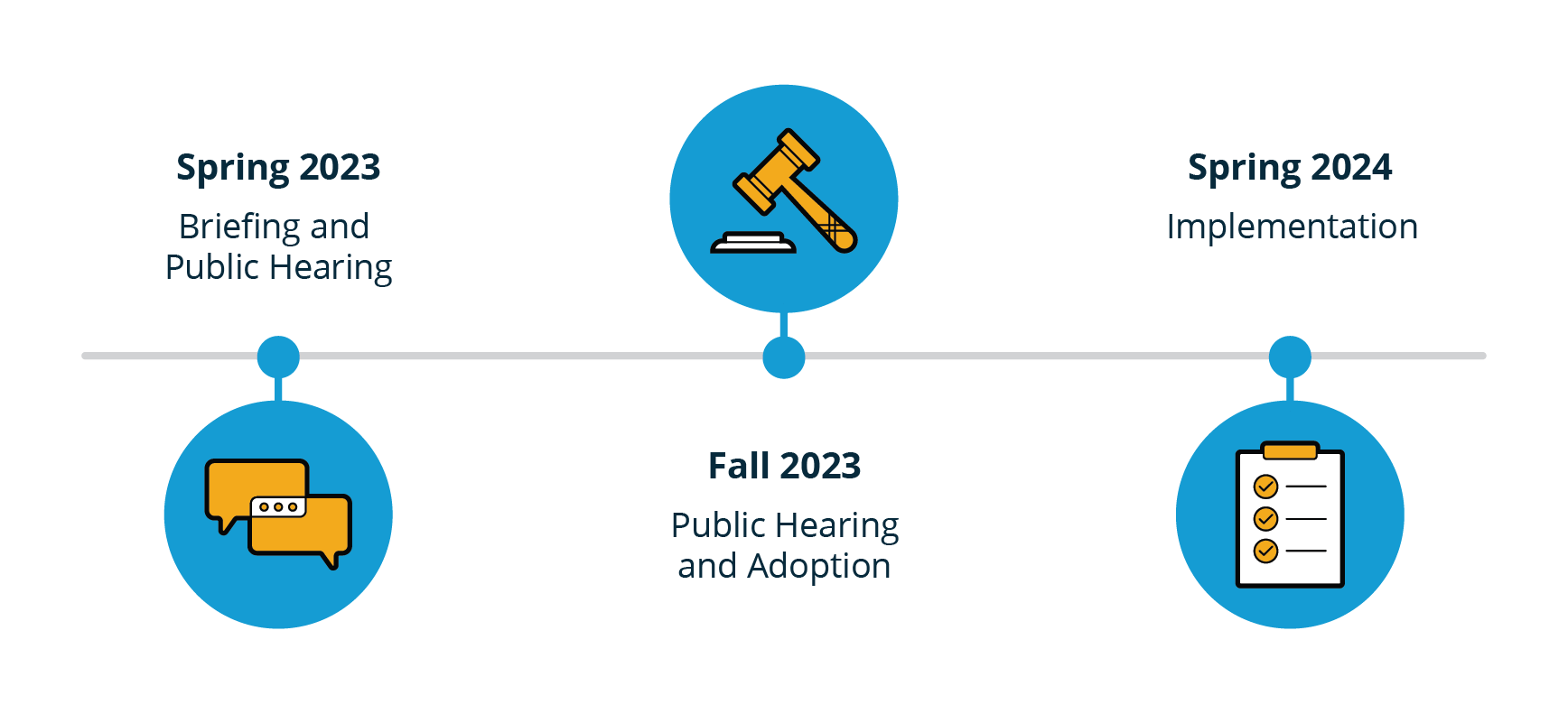
Survey Results
The city requested feedback from the community in two surveys. Over 2,100 people responded to a survey with general questions about housing in December 2019/January 2020. Nearly 300 people responded to a July 2020 survey with questions relating to options presented in an Affordable Housing Overlay Story Map.
Survey #1 (December 2019/January 2020)
Survey Summary
Two-thirds of survey respondents own their homes and 1/3 rent. This is a higher percentage of owners than the city as a whole – 2018 American Community Survey data from the U.S. Census reported 48% of Salt Lake City residents owned their homes.
Do you rent or own your residence?
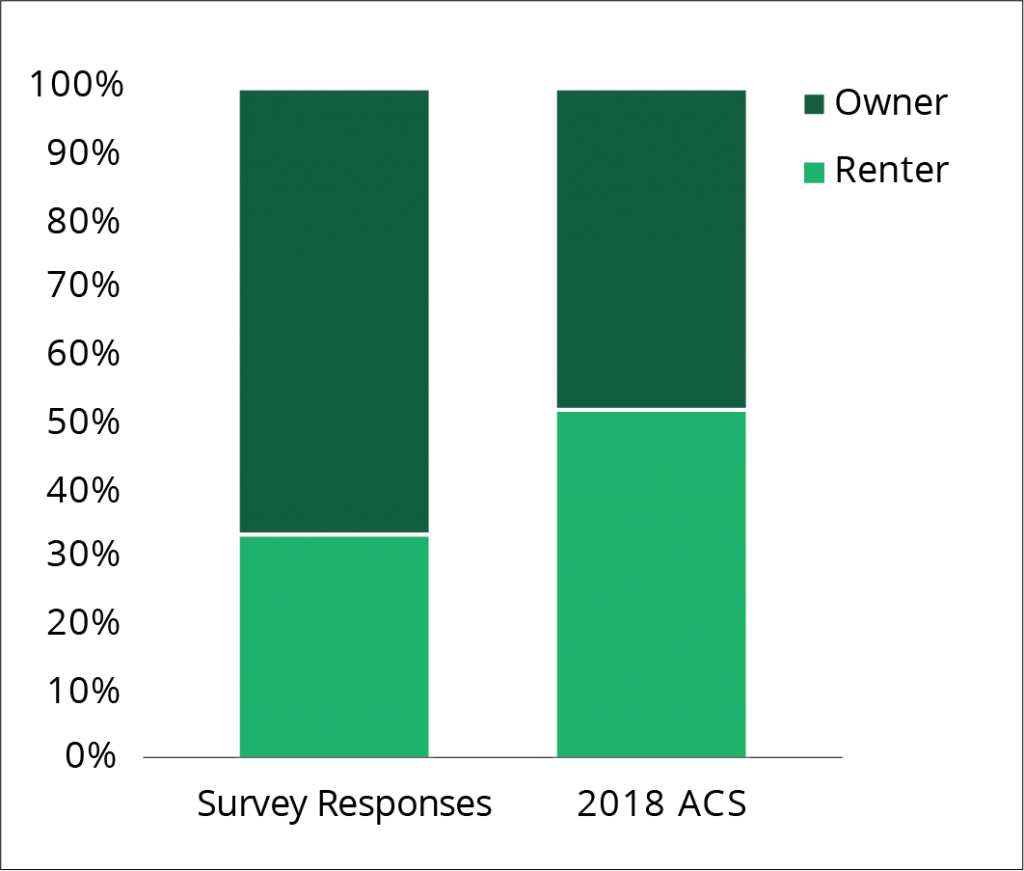
Many renters move frequently and expect to move in the next year or two. The two questions below are related to those that are renters:
How long have you lived at your current residence?

When do you anticipate moving to another residence?

Nearly 10% of respondents spend more than 50% of their income on housing. This is considered extremely cost-burdened. 31% spend between 31-50% of their income on rent and are considered cost-burdened. Over half, 59%, spend less than 30% on housing, which is considered affordable. Compared to the city as a whole, Growing SLC reported that nearly half of renters in Salt Lake City were cost-burdened and nearly a quarter were extremely cost-burdened.
Despite this, 56% stated that housing in Salt Lake City was not affordable. 40% considered it somewhat affordable and 4% considered it very affordable.
86% of respondents felt that affordable housing benefited the community. Nearly 8% selected “I don’t know” and 6% did not feel that it benefited the community.
Respondents were open to a variety of housing types in neighborhoods. Respondents were able to select multiple housing types they thought most appropriate for affordable housing in their neighborhood and single family homes were selected most often followed by duplexes, and townhouses.
What types of affordable housing do you think fits in your neighborhood?

80% of respondents stated that affordable housing should be in all neighborhoods. Nearly 83% of respondents felt there wasn’t enough affordable housing in Salt Lake City. Approximately two-thirds of respondents felt there wasn’t enough affordable housing in their neighborhood and 14% selected “I don’t know”. 20% of respondents thought their neighborhood had enough affordable housing.
When asked what areas had the biggest need for more affordable housing respondents were able to select multiple areas. Downtown was selected the greatest number of times followed by Sugar House, then Central Community.
What areas do you think have the biggest need for affordable housing?

Zoning regulations can affect the supply and location of affordable housing. Respondents thought that focusing affordable housing near transit routes, permitting greater residential density than is currently allowed, and zoning more land in Salt Lake City for multifamily housing would be the most effective ways of addressing the supply and location.
What are the most and least effective ways to address supply and location of affordable housing?
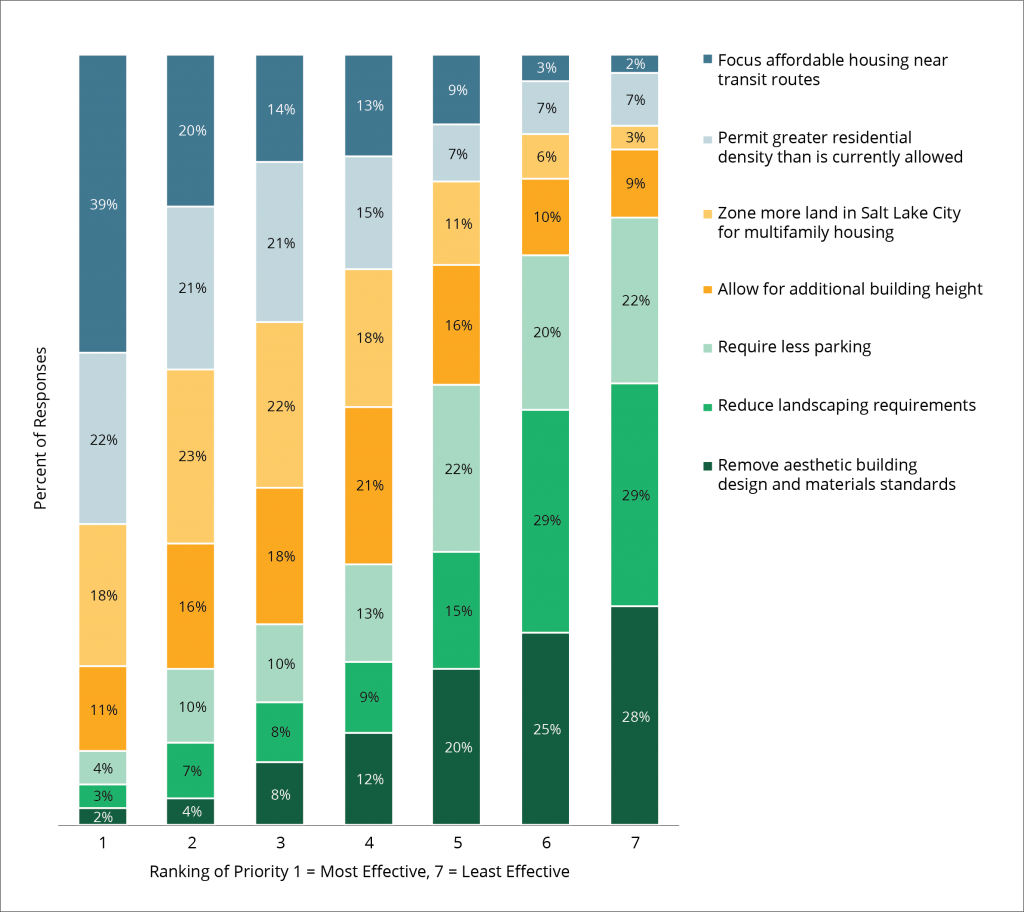
Respondents generally thought that amenities like light rail, grocery stores, schools, and parks should be within ¼ mile of affordable housing. Doctor’s offices/hospitals and other retail were less important and could be located ½ mile or further away.
How close should these amenities be to affordable housing?
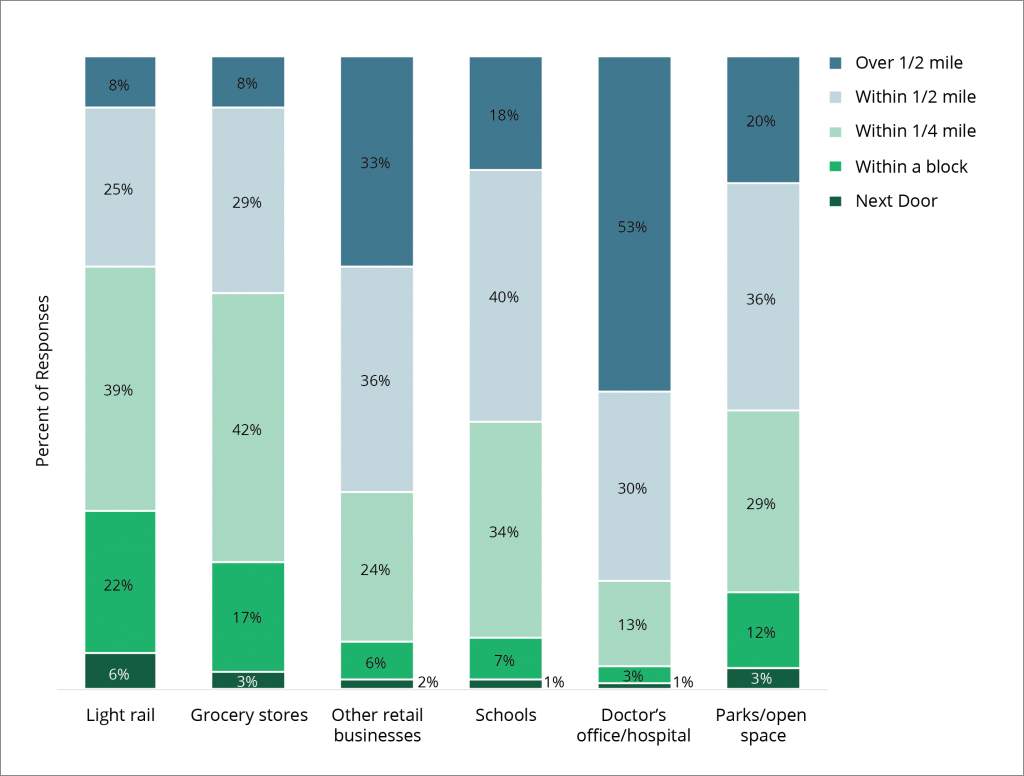
Survey respondents generally had higher incomes and more selected white as their ethnicity compared to the city as a whole. The household size and age of respondents were generally representative of the city as a whole.
View Complete Survey #1 Responses
Survey #2 (July 2020)
The information listed inside the drop-downs below are a summary of the survey responses.
Single-family and Middle Housing Questions
| Single-family and Middle Housing Questions |
Yes |
No |
Neutral |
|
Do you support allowing accessory dwelling units in single-family neighborhoods without a conditional use process if one of the units on the property is affordable? |
63.8% |
28.6% |
7.6% |
|
Do you support allowing duplex or two-family units in single-family neighborhoods if at least one of the two units is affordable? |
73.4% |
20.0% |
6.6% |
|
Do you support allowing townhomes in single-family neighborhoods that are near frequent public transit if at least 50% of the units are affordable? |
67.6% |
25.2% |
7.2% |
|
Do you support allowing townhomes in single-family neighborhoods that are along arterial roads if at least 50% of the units are affordable? |
66.7% |
23.0% |
10.3% |
|
Do you support allowing tiny houses and cottages in single-family neighborhoods that are near public transit if at least 50% of the units are affordable? |
68.0% |
22.7% |
9.3% |
|
Do you support allowing tiny houses and cottages in single-family neighborhoods that are along arterial roads if at least 50% of the units are affordable? |
69.0% |
24.8% |
6.2% |
|
Do you support easing restrictions on the number of units in residential multi-family zoning districts if affordable units are included? |
59.8% |
35.1% |
5.2% |
|
Do you support reducing minimum lot sizes or setbacks for the construction of affordable units? |
54.1% |
37.6% |
8.3% |
|
Do you support easing restrictions on lots with limited or no street frontage for the construction of affordable units? |
52.2% |
36.4% |
11.3% |
|
Do you support easing restrictions on the number of units in the adaptive reuse of a building if a percentage of the units are affordable units? |
71.0% |
21.0% |
7.9% |
|
Do you support allocating city staff and resources to administer affordable housing deed restrictions and documentation? |
74.1% |
16.6% |
9.3% |
Mixed Use and Multi-Family Questions
| Mixed Use and Multi-family |
Yes |
No |
Neutral |
|
Do you support waiving the Design Review requirement for additional building height (only applicable in zones where it is an option) for affordable housing? |
63.4% |
29.1% |
7.4% |
|
Do you support allowing additional building stories for affordable housing in neighborhoods where multi-family housing is permitted? |
73.0% |
19.7% |
7.3% |
|
Do you support allowing housing on public lands or institutional zoning districts for affordable housing? This would not include parks and open space. |
72.8% |
19.4% |
7.8% |
|
Do you support reducing minimum lot requirements for the construction of affordable units? |
73.2% |
21.8% |
5.0% |
|
Do you support removing restrictions that prohibit or require planning processes to develop lots with limited or no street frontage for the construction of affordable units? |
53.9% |
38.3% |
7.8% |
|
Do you support allowing single family, duplexes, townhouses, and other types of housing near downtown and in commercial districts where they are not currently allowed but multi-family is allowed? Affordable housing must be a component. |
84.8% |
12.4% |
2.8% |
|
Do you support allocating city staff and resources to administer affordable housing deed restrictions and documentation? |
78.3% |
11.7% |
10.0% |
Demographics
A comparison of the survey respondent demographics with similar 2018 5-year American Community Survey (ACS) data from the U.S. Census shows that the survey respondents, when compared to the city as a whole, are generally more likely to own homes rather than rent, are younger or middle-aged, have higher incomes, are more likely to be white, and are more likely to be men.

The age categories in the survey are not directly comparable to those in the American Community Survey (ACS), but respondents were generally younger than the city as a whole.


Survey respondents generally had higher incomes than the city as a whole.

The race and ethnicity categories are also not directly comparable, but survey respondents were more likely to be white and less likely to be Hispanic or Asian that the city as a whole.
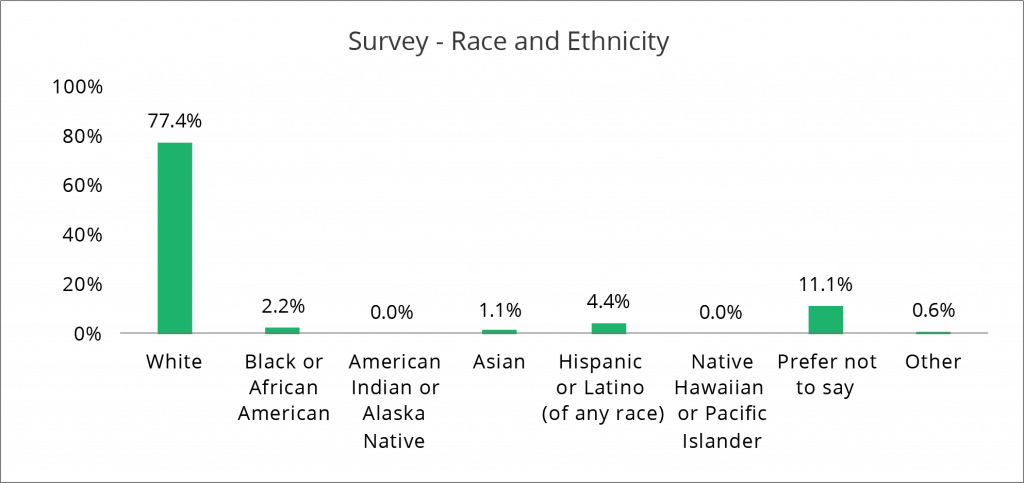


Survey respondents were also more likely to be men or not report a gender.


View Complete Survey #2 Responses – Single-family and Middle Residential
View Complete Survey #2 Responses – Multi-family and Mixed-Use Housing
*Note: The percentages in the pdf document include those who skipped the question.
If you have any questions, please contact:
Sara Javoronok
sara.javoronok@slcgov.com
801-535-7625